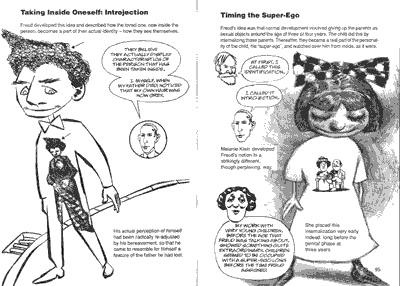Rose and I got some fun books from Half Price Books the other day. They’re published by Icon Books, which publishes “intelligent non-fiction.” We purchased Introducing Derrida, Introducing Foucault, and Postmodernism for Beginners (which seems to be the same book as Introducing Postmodernism listed in Icon’s catalogue).
(I hesitated to call it the “same” book, as I was reminded suddenly of the Philosophy 101 problem of identity and ships. One plank on the deck of a wooden ship is replaced with a new one. Is the ship with a replaced plank the same ship as the pre-replacement ship? How many planks must be removed before the ship becomes a different ship? One plank? All of them? A single splinter of one plank? Does the ship have a constant identity which survives replacements of planks? What about humans, in whose bodies cells constantly die and are replace with new cells? An obvious answer [to me, anyway] is that the ship is both same and different, or neither same or different.)
Not all would call these books comic books, I guess. This excerpt from Introducing Melanie Klein illustrates what the books look like:
Postmodernism for Beginners usually clearly distinguishes typeset text from comics with handwritten speech balloons, but the two often mix together. Introducing Derrida blurs the distinction by setting the speech balloons in type and mixing text and pictures more freely. Are these books comic art, or are they prose illustrated with comic art? What is “comic art?”
I know of two well-known and widely used definitions (I’d like to learn of others if any of you readers know of them): Will Eisner’s “sequential art” and Scott McCloud’s elaboration: “juxtaposed pictorial and other images in deliberate sequence, intended to convey information and/or produce an aesthetic response in the viewer” (Understanding Comics, p. 9).
In Understanding Comics, McCloud takes care to create a definition of comics that doesn’t encompass written words. Comic art must include pictorial images. That means Seaguy—a sequence of pictorial and other images—is a comic, but War and Peace—a sequence of non-pictorial images (letters, punctuation, etc.) is not a comic. This blog post is a comic. An illustrated War and Peace would be a comic.
Craig Thompson’s Blankets is called an “illustrated novel” on its cover. Illustrations are used to clarify or explain. In an illustrated text, the illustrations are subordinate to the text (in my experience). In Thompson’s comic book, his pictures are stronger than his words. The pictures convey powerful meaning, and the words are often pale illustrations of the pictures. Why is Blankets called an “illustrated novel?” Probably because Thompson, or somebody, thought it sounds better (i.e., most people don’t associate it immediately with comic books) than “graphic novel.” “Pictorial novel” is too obvious—people would realize it’s still a comic book. But I’m less interested in why Thompson (or somebody) would want to superficially obfuscate Blankets’s status as a comic book than in why he chose “illustrated novel” as the obfuscatory term, whether he considered the connotation of subordination in the word “illustrated.” (See also Rose’s “But ‘comic book’ doesn’t work for what we do these days.”)
(”Novel” causes as many problems as “illustrated.” “Raina” is a combination of two of Thompson’s ex-girlfriends. Thompson neglects to mention in the book that he has a sister as well as a brother. Is Blankets autobiography? Autobiographical fiction or fictionalized autobiography? Fiction or nonfiction? Both and neither?)
Should pictorial images dominate in comics? Or should they never be subordinate? Both seem risky additions to the definition of comics. The latter at least would likely lead to the rejection of Understanding Comics as a comic.
What is comic art?

Dorian says:
Some editions of the Icon books are “… for Beginners” and some are “Introducing …” It apparently has to do with a company called Writers and Readers who were also doing “… for Beginners” books in the same comics-type format.
I’ve got dozens of the things. They turned out to be very good study guides in college, particularly the Icon ones. The “Postmodernism” one is particularly good.
— 13 August 2004 at 3:50 am (Permalink)
Steven says:
I returned to Half Price yesterday and returned with Existentialism and Linguistics. They are indeed very good, and I want them all.
— 13 August 2004 at 12:15 pm (Permalink)